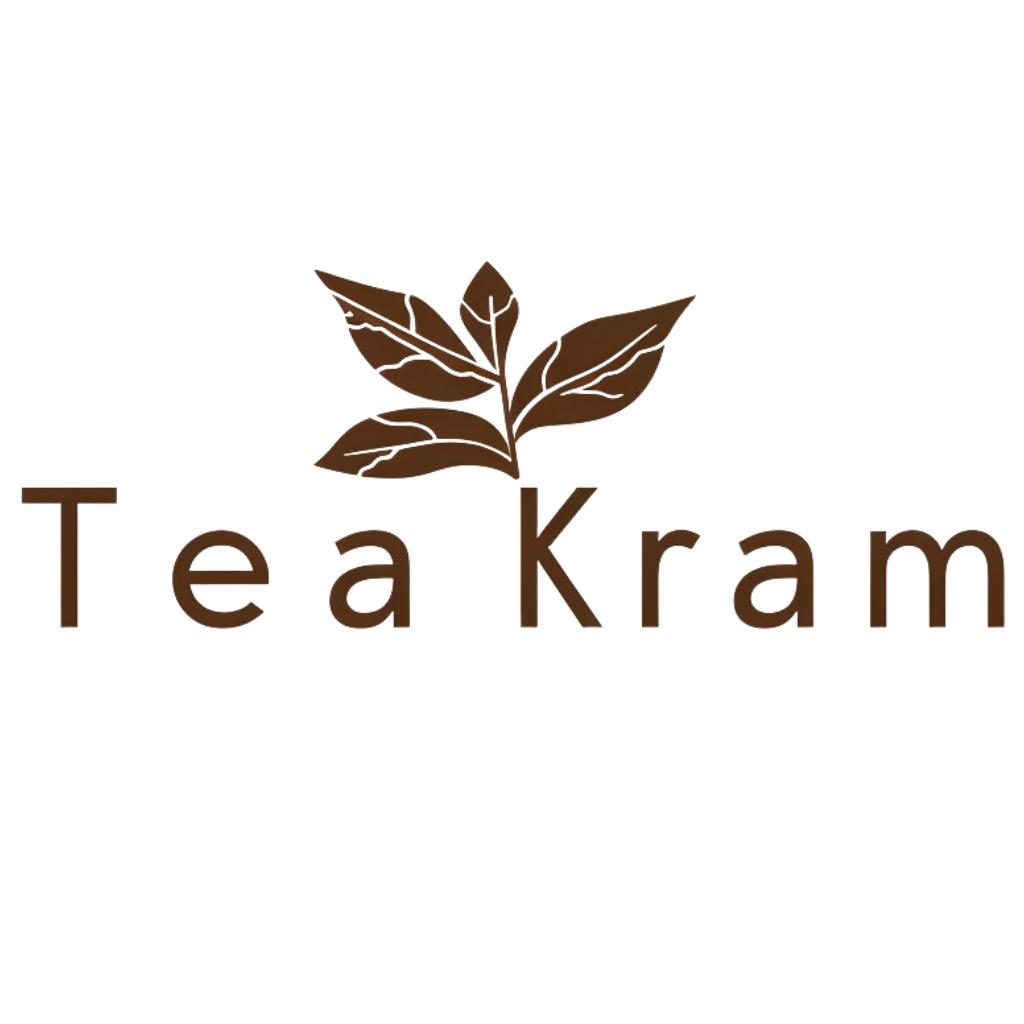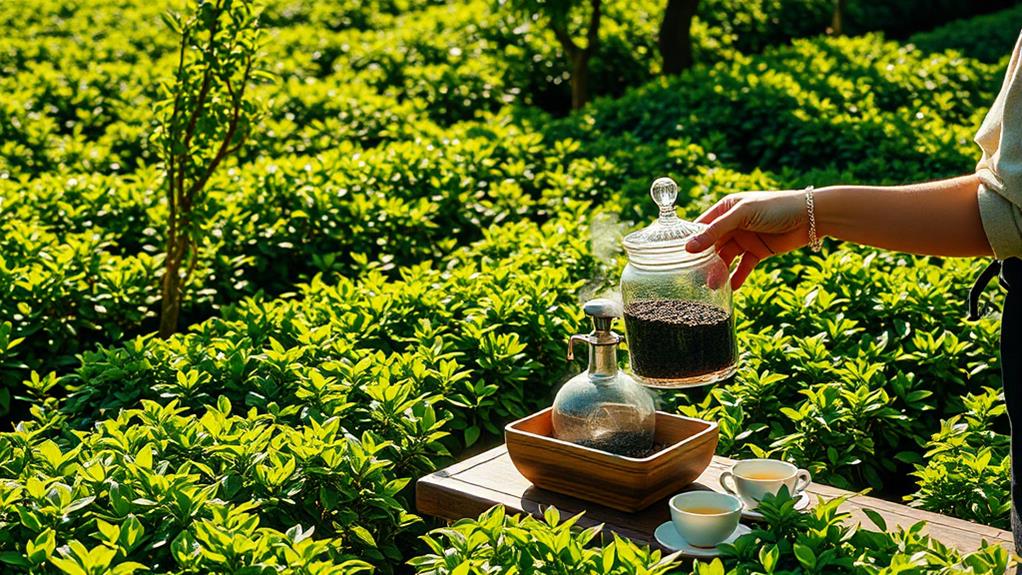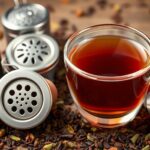Tea is decaffeinated using several methods to remove caffeine while keeping its delicious flavors and health benefits. One common way is the Swiss Water Process, which uses water and charcoal to filter out caffeine without chemicals. Another method is the Carbon Dioxide Method, where pressurized CO2 selectively extracts caffeine while preserving taste. Other options include methods using steam or natural solvents like ethyl acetate. Decaffeination can change a tea's flavor, often making it milder, but it still retains healthy antioxidants. Curious about how these methods influence your favorite teas? Well, there's more to explore!
Understanding Decaffeination
When it comes to understanding decaffeination, it's important to know that the process removes caffeine from tea leaves while preserving their flavor and beneficial compounds. You might wonder how this magical transformation happens. Well, it involves several innovative methods, each designed to keep the tea's essence intact.
One common technique is the use of water, where tea leaves soak in hot water to extract caffeine. You'll be surprised to learn that this method also draws out some of the tea's rich flavors and nutrients, which is why it's carefully controlled.
Another method involves using carbon dioxide, a more high-tech approach. In this process, CO2 is pressurized and applied to the tea leaves, selectively removing caffeine without compromising the flavor. It's like using a futuristic vacuum cleaner for caffeine!
While decaffeinated tea may not pack the same punch as its caffeinated counterpart, it still offers a delightful experience.
The Importance of Caffeine
Recognizing caffeine's role in our daily lives highlights its importance beyond just a morning pick-me-up. Caffeine can boost your energy levels, enhance your focus, and even improve your mood. It's a powerful tool that many of us rely on to tackle our busy days.
Additionally, the antioxidants found in tea can further support overall well-being, promoting health benefits while providing that necessary caffeine boost natural source of antioxidants. Imagine waking up feeling groggy, and then, with just a sip of your favorite caffeinated beverage, you find yourself more alert and ready to conquer challenges.
But caffeine does more than just wake you up. It plays a role in social interactions, too. Coffee breaks and tea time aren't just about the drink; they're moments for connection. Sharing a cup with friends or colleagues can spark creativity and collaboration.
Plus, some studies suggest that caffeine may even support long-term brain health, keeping your mind sharp as you age.
Common Decaffeination Methods
For those who enjoy tea but want to cut back on caffeine, understanding how tea is decaffeinated can be enlightening.
One common method is the use of chemical solvents, such as ethyl acetate or methylene chloride. These solvents selectively bond with caffeine molecules, allowing them to be washed away, while leaving other flavorful compounds intact. It's a bit like using a magnet to pull away unwanted metal!
Another popular technique is the carbon dioxide method. Here, carbon dioxide is pressurized until it turns into a liquid. This liquid then extracts caffeine from the tea leaves. Since this method doesn't involve chemicals, it's often favored by those looking for a more natural approach.
Finally, there's the hot water method, where tea leaves are soaked in hot water to dissolve the caffeine. The water is then filtered, and the leaves are dried again.
While this method is straightforward, it mightn't preserve as much flavor as the others.
The Swiss Water Process
Among the various decaffeination methods, the Swiss Water Process stands out for its commitment to a chemical-free approach. This innovative technique relies on water and osmosis to remove caffeine from coffee beans, and it's now being applied to tea as well.
When you enjoy a cup of tea made with this method, you can savor the flavor without worrying about chemicals.
Here's how it works:
- Soaking: The tea leaves are soaked in hot water, allowing caffeine and some flavors to dissolve into the water.
- Filtering: The water is passed through a charcoal filter that captures the caffeine but lets other flavor compounds flow through.
- Reusing: This flavor-rich water is then used to soak new batches of tea leaves, ensuring that the taste remains intact while the caffeine is removed.
With the Swiss Water Process, you're choosing a natural and eco-friendly option that lets you enjoy your tea without the jitters.
It's an exciting way to experience the full flavors of tea while keeping it light on caffeine. So, go ahead, indulge in that soothing cup of decaf!
Carbon Dioxide Method
While the Swiss Water Process offers a natural way to decaffeinate tea, the Carbon Dioxide Method presents a more modern and efficient alternative. This innovative technique uses carbon dioxide in a supercritical state, which means it has properties of both a gas and a liquid.
When you apply high pressure to carbon dioxide, it can selectively extract caffeine from the tea leaves without stripping away the essential flavors and oils.
Imagine being able to enjoy your favorite tea without the jitters, while still savoring its rich taste! During the process, the tea leaves are soaked in water, allowing the caffeine to dissolve.
Then, the carbon dioxide is introduced. It binds with the caffeine and pulls it away from the leaves. This method isn't only effective but also environmentally friendly, as the CO2 can be reused multiple times.
What's fantastic about the Carbon Dioxide Method is that it preserves the quality and aroma of the tea, making it a popular choice for those who want to enjoy a cup without caffeine.
Ethyl Acetate Process
Now, let's explore the Ethyl Acetate Process, a popular method for decaffeinating tea.
This technique uses a natural compound found in fruits, making it a more appealing option for those who want a gentler approach to caffeine removal.
While it offers some benefits, like preserving flavor, there are also drawbacks you should know about, so let's break it down!
Ethyl Acetate Overview
In the ethyl acetate process, tea leaves are treated with a naturally occurring compound called ethyl acetate, which is derived from fruits. This method is popular because it effectively removes caffeine while preserving the tea's flavor and aroma.
It's a fascinating approach that highlights innovation in tea processing.
Here are three key points about the ethyl acetate process:
- Natural Source: Ethyl acetate comes from the fermentation of fruits, making it a more natural choice compared to some synthetic alternatives. You can feel good knowing it's derived from nature!
- Flavor Retention: One of the best things about this method is that it maintains the essential oils and flavors in the tea leaves. You won't have to sacrifice taste for a lower caffeine content.
- Environmentally Friendly: The ethyl acetate process is often seen as a greener option in the world of decaffeination. It generally requires less energy and produces fewer harmful byproducts compared to other methods.
Benefits and Drawbacks
The ethyl acetate process offers several benefits, but it also has its drawbacks. One major advantage is that it's relatively gentle on the tea leaves, preserving their flavor and aroma better than some other methods.
You'll appreciate that this process uses a naturally occurring compound, which can make it feel more appealing if you're concerned about chemicals in your food. Plus, it's efficient, removing a significant amount of caffeine without needing excessive processing.
However, there are downsides to take into account. Some people worry about trace amounts of ethyl acetate remaining in the tea, although regulatory standards generally guarantee these levels are safe.
Additionally, while the method does a great job of keeping flavor intact, it mightn't remove all the caffeine, leaving you with a cup that still packs a slight punch.
Pros and Cons of Decaffeination
Decaffeination offers a mix of advantages and disadvantages that can impact your tea experience. Understanding these pros and cons can help you make informed choices about which tea to sip.
Additionally, it's essential to acknowledge that decaf teas typically retain some health benefits, albeit at a reduced level compared to their caffeinated counterparts, allowing you to enjoy a soothing cup without the caffeine jitters.
Many decaf teas can still provide moderate antioxidant levels, which are beneficial for your overall health, making them a popular choice for many tea lovers caffeine sensitivity affects individuals.
Pros:
- Better Sleep: Decaffeinated tea can be a great choice for those who want to enjoy a warm beverage without the jitters that caffeine can bring, especially before bedtime.
- Health Benefits: Many decaffeinated teas still retain their antioxidants, keeping the health benefits intact while reducing caffeine intake.
- Versatility: You can enjoy decaf tea anytime, whether you're at work or winding down at home, without worrying about your caffeine limits.
Cons:
- Flavor Changes: Some people notice that decaffeinated tea can taste different, which mightn't appeal to everyone.
- Processing Methods: The decaffeination process can sometimes involve chemicals, which may concern health-conscious drinkers.
- Limited Options: Depending on your favorite blends, you may find fewer choices in the decaffeinated section, which could limit your enjoyment.
Weighing these factors can help you enjoy a balanced tea-drinking experience!
Impact on Flavor Profile
Flavor can change considerably when tea is decaffeinated, affecting your overall experience. You might notice that the vibrant notes you love in your favorite black or green tea might taste a bit different after decaffeination.
While the process aims to preserve the tea's original flavors, some delicate aroma compounds can be lost along the way. This means you could end up with a lighter, sometimes flatter taste compared to its fully caffeinated counterpart.
But don't worry! Many innovative decaffeination methods have emerged to tackle this issue. Some techniques, like the CO2 method or water processing, endeavor to maintain the rich flavors and aromas you expect from high-quality tea.
You might even discover new flavors that surprise you, as the absence of caffeine can highlight different taste notes.
Quality Considerations
When you think about quality in decaffeinated tea, it's important to contemplate how different methods affect the final product.
Each decaffeination process can change the tea's flavor and aroma, so you'll want to choose one that meets your taste.
Plus, you might also want to weigh the benefits of organic versus conventional options to guarantee you're sipping on the best brew possible!
Decaffeination Methods Explained
In the world of tea, understanding the various decaffeination methods is crucial for maintaining quality. You might be surprised to learn that several innovative techniques exist, each with its own advantages.
By knowing these methods, you can appreciate your decaffeinated tea even more.
1. Direct Solvent Method: This technique uses chemical solvents to remove caffeine from the leaves. While effective, you'll want to verify that the solvents used are food-safe and properly rinsed away.
2. Carbon Dioxide Method: In this method, supercritical carbon dioxide extracts caffeine while preserving flavor compounds.
It's an eco-friendly choice, appealing to those who care about sustainability.
3. Water Method: Also known as the Swiss Water Process, this method uses water to extract caffeine, guaranteeing a clean, chemical-free result.
It's perfect for those seeking a natural option.
Impact on Flavor Profile
Decaffeinated tea can markedly differ in taste compared to its caffeinated counterpart, often leaving you wondering how the decaffeination process impacts its flavor profile.
When tea leaves lose caffeine, they also undergo changes in their chemical composition, which can affect the tea's overall taste and aroma. You might find that some methods, like the CO2 process, manage to retain more of the original flavors, while others, such as the chemical solvent method, could leave a slightly altered taste.
You may notice that decaffeinated teas often have a milder flavor. This doesn't mean they're any less enjoyable; it just means that you'll experience a different, subtler taste.
Some brands even experiment with enhancing the flavors post-decaffeination, using natural essences or blends to create exciting new profiles.
Organic vs. Conventional Choices
Choosing between organic and conventional decaffeinated tea often boils down to personal preferences and quality considerations. Each option has its benefits and drawbacks, and understanding them can lead you to make a more informed choice.
Additionally, opting for organic tea can contribute to a more sustainable brewing practice, as it supports eco-friendly farming methods that minimize environmental impact and promote biodiversity environmental footprint.
When you're exploring these two paths, consider these key factors:
- Pesticide Use: Organic tea is grown without synthetic pesticides or fertilizers, which can be better for your health and the environment. Conventional teas might've residues from these chemicals.
- Flavor and Quality: Many tea enthusiasts argue that organic teas often offer richer flavors and better quality, thanks to the careful cultivation practices. Conventional teas might be less costly but could lack that depth of taste.
- Sustainability: Choosing organic supports farming practices that are more sustainable and can help preserve biodiversity. Conventional methods may prioritize yield over ecological balance.
In the end, whether you opt for organic or conventional decaffeinated tea, it's all about what resonates with you.
Choosing Decaf Tea
When it comes to selecting decaf tea, you'll want to take into account a few key factors to guarantee you find a blend that suits your taste.
First, consider the type of tea you enjoy. Whether it's black, green, or herbal, each has unique flavors that can impact your choice. Look for brands that use innovative decaffeination methods, as these often preserve the tea's natural essence better than traditional techniques.
Next, check the ingredients. Some decaf teas come with added flavors, herbs, or spices, which can elevate your experience. You might find a delightful chai blend or a invigorating mint infusion that excites your palate.
Don't forget to explore organic options if you're looking to avoid pesticides. Many brands offer high-quality organic decaf teas that align with your values.
Lastly, read reviews or ask for recommendations. Fellow tea lovers often have insights into the best blends.
Experimenting is part of the fun, so don't hesitate to try a few different varieties until you discover your perfect cup. Enjoy the journey of finding your ideal decaf tea!
FAQ
Is Decaf Tea Completely Caffeine-Free?
Decaf tea isn't completely caffeine-free. It typically contains a small amount of caffeine, often around 2-5 milligrams per cup. If you're looking to avoid caffeine entirely, consider herbal tea instead.
Can Decaf Tea Still Affect Sleep Quality?
Decaf tea can still disrupt your sleep's serenity. Even with lower caffeine, individual sensitivity varies. If you're seeking sound slumber, consider sipping herbal alternatives, ensuring nightly relaxation without risking restless nights or disrupted dreams.
How Does Decaf Tea Compare in Antioxidants to Regular Tea?
Decaf tea still contains antioxidants, but the levels might be slightly lower than regular tea. If you're seeking health benefits, enjoy both types; just remember, decaf can offer a gentler caffeine-free option for your routine.
Is Decaf Tea Safe for Pregnant Women?
When it comes to decaf tea and pregnancy, you're in the clear! Just sip with caution, as some blends may still contain trace caffeine. Always check with your doctor to ascertain you're playing it safe.
Are There Any Health Risks Associated With Decaf Tea?
While decaf tea generally poses minimal health risks, you should be aware of potential additives and processing methods. Always choose high-quality brands to guarantee you're enjoying a safe, innovative beverage without unwanted chemicals.
Final Thoughts
In the world of tea, decaffeination offers a delightful choice for those wanting the soothing experience without the caffeine buzz. Whether you prefer the Swiss Water Process or the Carbon Dioxide method, each approach has its own unique quirks and benefits. Just like a good cup of tea, understanding decaf isn't just about what's missing; it's also about what you gain—a smoother, calmer sip. So, next time you reach for a cup, you can savor both flavor and relaxation!



